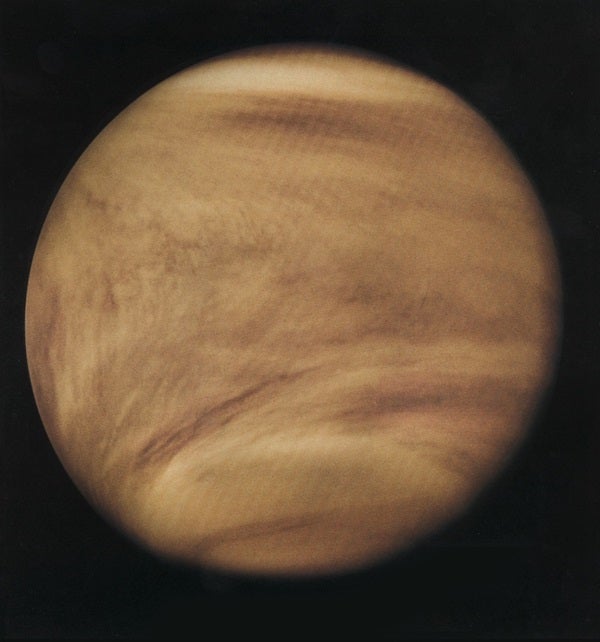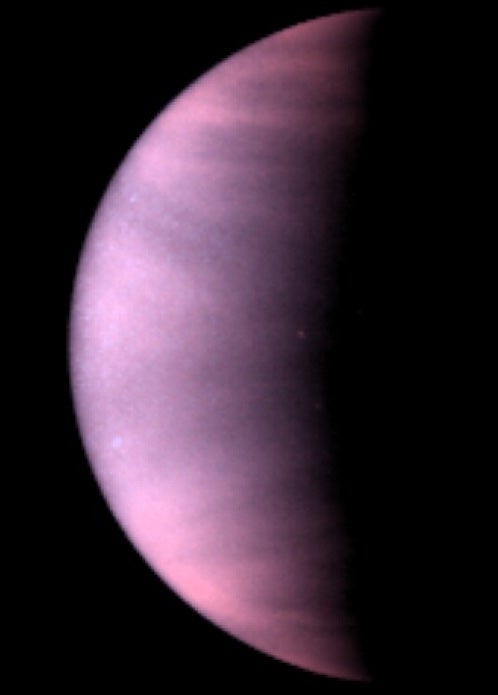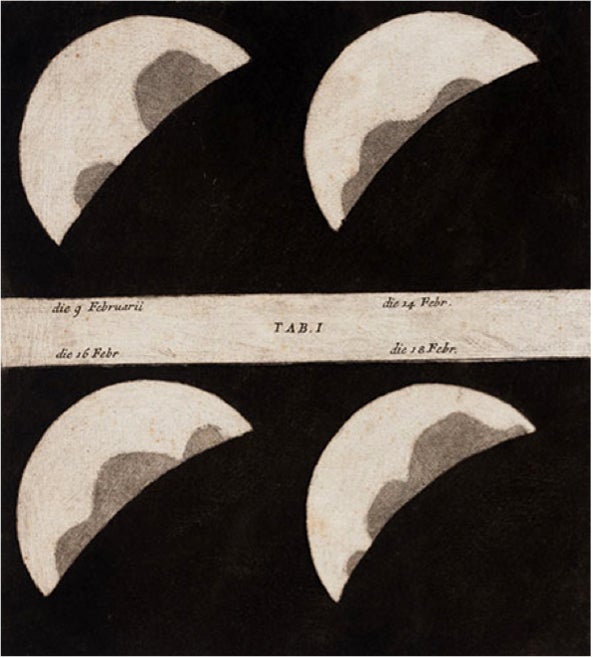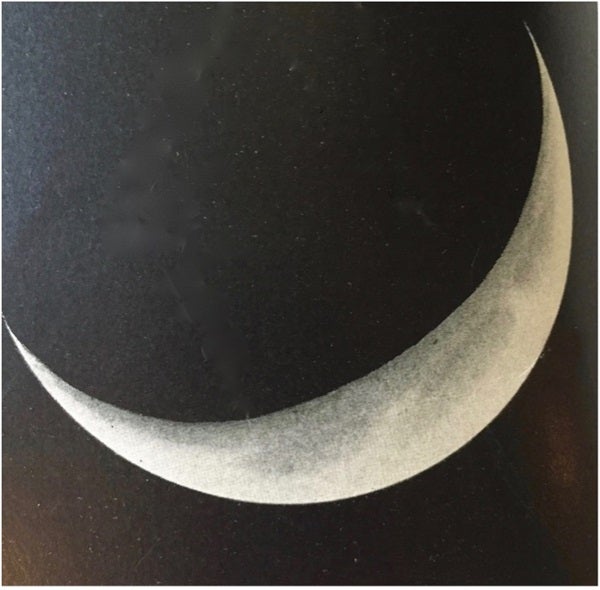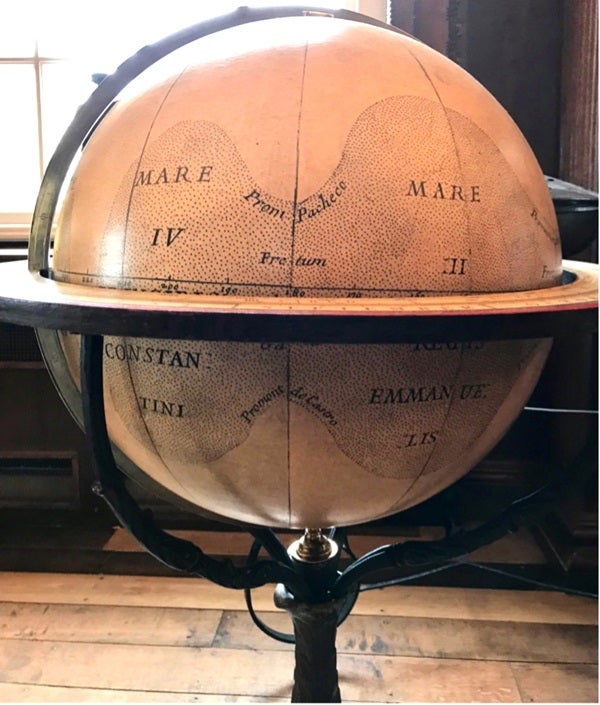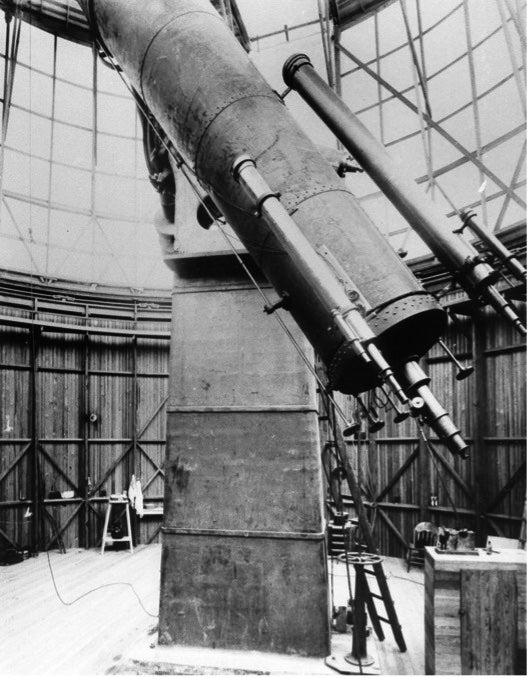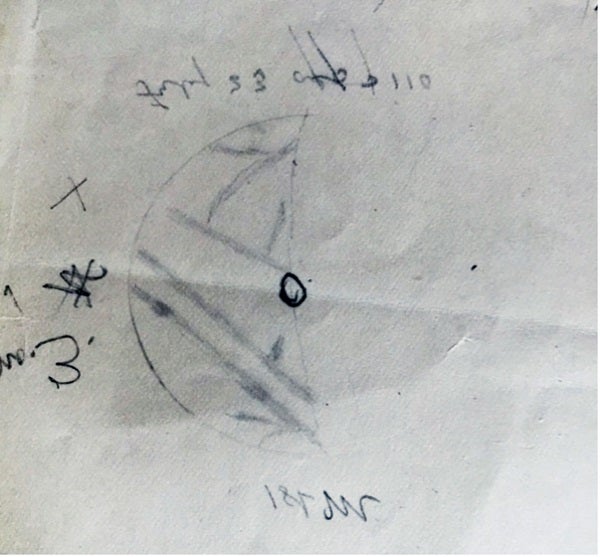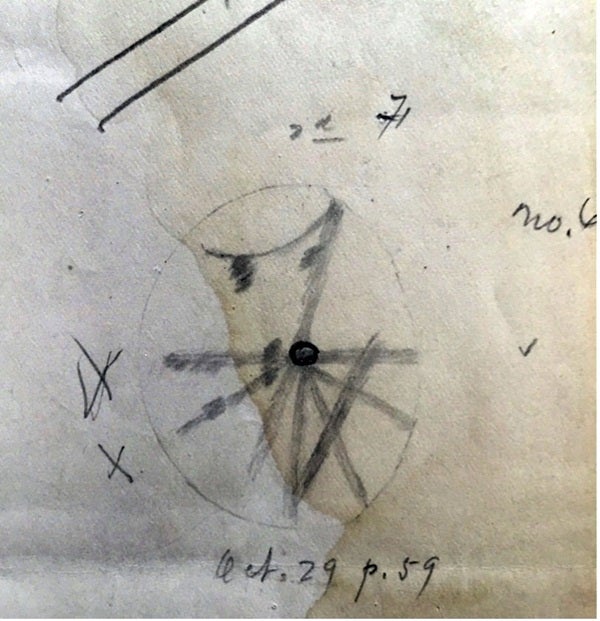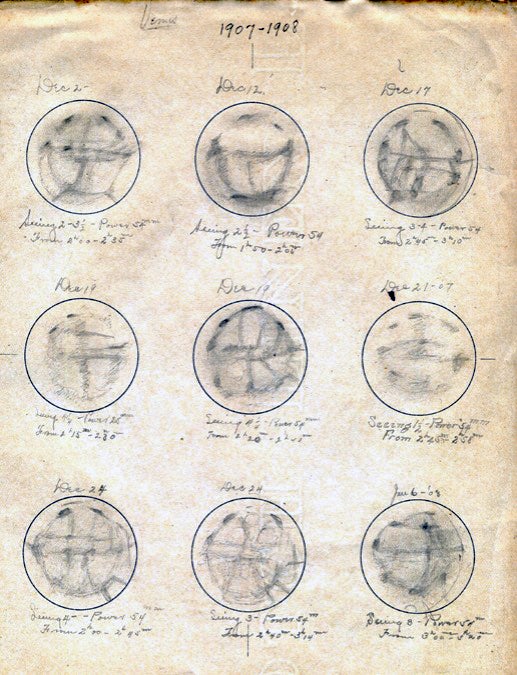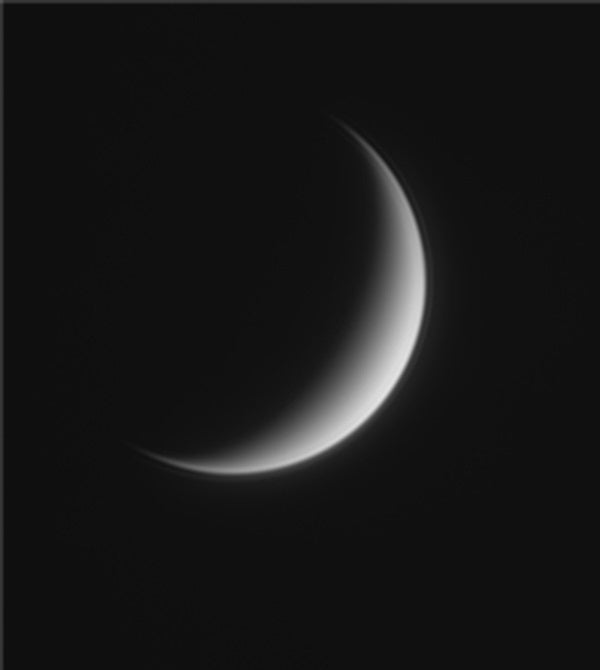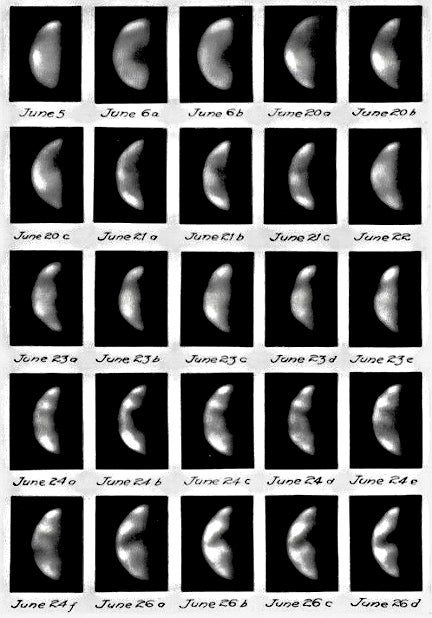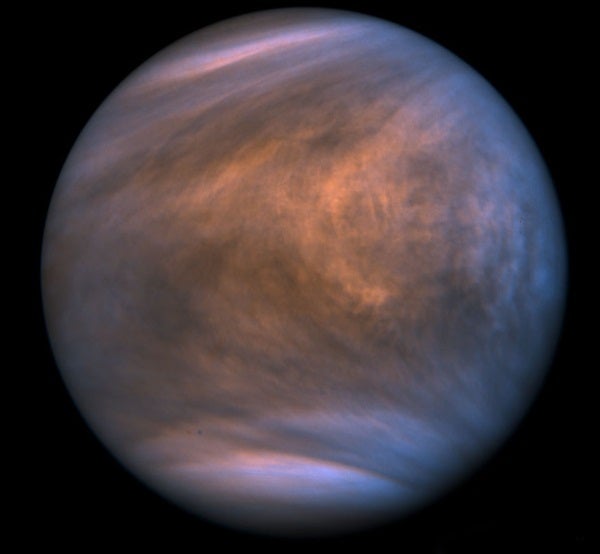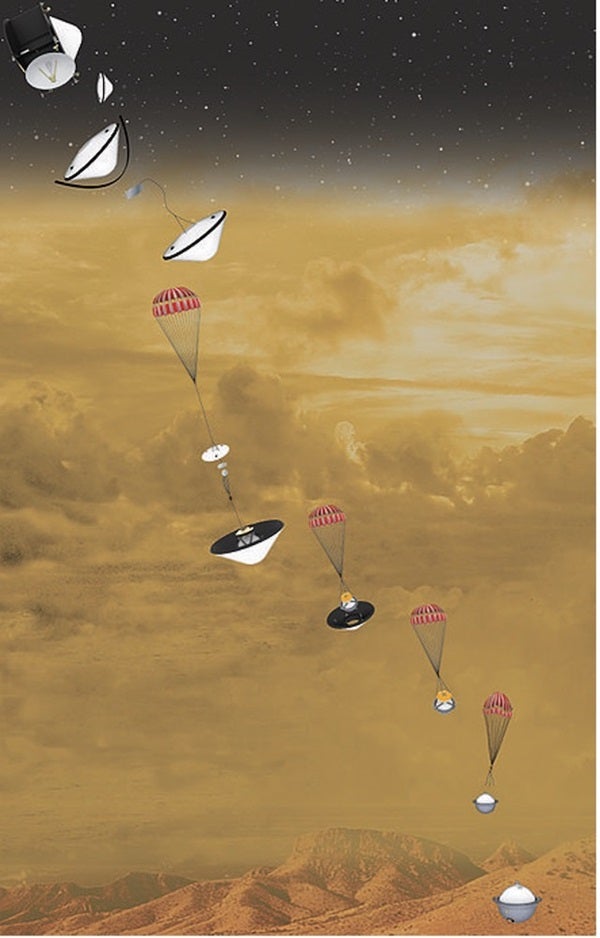As brilliant and splendid as Venus is to the naked eye, the world often ranks as one of astronomy’s great telescopic disappointments. Apart from its evolving phase and its dazzling, ubiquitous cloud deck, the casual observer can see very little detail. As brilliant and splendid as Venus is to the naked eye, the world often ranks as one of astronomy’s great telescopic disappointments. Apart from its evolving phase and its dazzling, ubiquitous cloud deck, the casual observer can see very little detail.
The famed English amateur astronomer William F. Denning wrote in Telescopic Work for Starlight Evenings (1891): “When the telescope is directed to Venus it must be admitted that the result hardly justifies the anticipation. Observers are led to believe, from the beauty of her aspect as viewed with the unaided eye, that instrumental power will greatly enhance the picture. … But the hope is illusive.” This assessment is as true today as when Denning wrote it in the late 19th century. However, with diligent courtship, and by observing with good instruments under the most favorable conditions, the so-called planet of love gradually becomes more forthcoming.
To view Venus against the backdrop of a dark sky is an exercise in futility. Instead, serious students observe it during daytime (or, at least, around sunrise or sunset), when careful study begins to reveal a few of the planet’s definite features. These include the bright cusp caps and bordering dark collars, first seen in 1813 by the keen-sighted Bavarian astronomer Franz von Paula Gruithuisen with only a 2-inch refractor. Indeed, astronomers now know the caps and collars indicate polar cloud swirls — gigantic storm systems like hurricanes on Earth.
Venus certainly has no spots or belts of bold outline like those visible on Jupiter and Mars. But most patient observers will make out a few diffuse, nebulous shadings. They are rarely defined well enough to render in drawings, and hardly seem deserving of close attention. But remarkably, even in the spacecraft era, their nature remains unexplained. In fact, they pose some of the most tantalizing questions our solar system has to offer, including, some have argued, the possibility that life may have once originated on the now inhospitable surface of Venus, long ago evolving to survive exclusively in the clouds.
An unheralded 18th-century pioneer
The first noteworthy study of Venus’ cloud features was made by the Rev. Francesco Bianchini, whose service to his church included the role of papal chamberlain to Pope Alexander VIII. Bianchini was a man of wide interest, a perceptive astronomer engaged in calendrical reform. And in 1726, he conducted a study of Venus as an “evening star.”
To investigate Venus, Bianchini, aided by a workman, set up telescopes at various sites around Rome, including on Palatine Hill near the palace of the Caesars. His best views were obtained using telescopes made by the Roman instrument-maker Giuseppe Campani, which likely had apertures around 2.4 inches and magnifications of 112x. Starting about half an hour after sunset and continuing for as long as he could, Bianchini discovered a series of dusky spots on Venus comparable in appearance to the seas of the Moon as seen with the naked eye, though less distinct. Adding further observations during the next morning and evening, he went on to create pieces (gores) for a globe. He named the observed spots for Catholic explorers, such as Columbus, Vespucci, and Galileo, and monarchs, such as the Portuguese prince Henry the Navigator and his patron the Portuguese King John V.
Although Bianchini’s comparison of the features to lunar seas and his deduced rotation period of 24.3 days proved spurious, it seems his spots were genuine. In fact, a number of 19th-century astronomers saw similar spots on Venus, roughly circular in form and hugging the terminator. None, however, were well-defined enough to enable them to estimate a rotation period for the planet, which we know now spins backwards once about every 243 Earth days.
A strange interlude
For over a century, vague markings on Venus such as those Bianchini spotted were generally regarded to capture the essential appearance of the planet. But at the end of the 19th century, the American astronomer Percival Lowell triggered a firestorm — not with his measurement of the planet’s rotation period, but with the way he perceived the features.
Using the 24-inch Clark refractor, which he set up first at Flagstaff and then at Tacubaya near the national observatory of Mexico in Mexico City, he perceived the markings of Venus to resemble the spokes of a wheel. He described these features in a flurry of articles, some with maps, which he published in scientific journals, as well as popular magazines, newspapers, and even literary outlets like The Atlantic Monthly. Lowell wrote that the so-called spokes were “surprisingly distinct; in the matter of contrast, as accentuated, in good seeing, as the markings on the Moon … in the matter of contour, perfectly defined throughout.” He regarded them as surface features seen through the transparent veil of Venus’ atmosphere and believed their motion unequivocally supported a 224.7-day rotation period for our sister world.
Lowell’s observations and the conclusions he reached from them were, as French astronomer and author Camille Flammarion noted, “entirely at variance with all that has gone before.” A few of Lowell’s assistants at Flagstaff — especially his secretary, Wrexie Louise Leonard — drew the markings much like he did. But the rest of the astronomical world was unanimous in its criticism. The response was unusually harsh (though perhaps deserved) and contributed to Lowell’s nervous breakdown when he came back from Mexico. Nonetheless, he held forth on the reality of his markings after he returned to Flagstaff in 1901. His first order of business was acquiring a Brashear spectrograph and placing it in the hands of his assistant, Vesto Melvin Slipher, so that he might confirm the longer rotation period and buttress the original Flagstaff observations. Lowell never disavowed the spokelike markings, and he and his assistants continued to draw the linear features when sketching Venus, though the later marks were not as regular as those initially reported. In general, as with his observations of the canals of Mars, Lowell’s work cast considerable doubt on the worth of visual studies of the planets.
According to famed English amateur astronomer Sir Patrick Moore, whose book The Planet Venus (Macmillan, 1958) was the bible of Venus studies during that era: “Visual observations made at the eye-end of a telescope are of little use to us here, so we must turn instead to photographic results.”
Photos to the rescue
At first, photography of Venus yielded no more insight than visual observations. It seems that French astronomer Ferdinand Quénisset made the maiden attempt at venusian photography in 1911 at Camille Flammarion Observatory in Juvisy-sur-Orge, France, imaging the planet in visible light. The new view, however, showed very little. The real breakthrough came when Frank Elmore Ross of the Yerkes Observatory photographed Mars and Venus using colored filters during a sabbatical year at Mount Wilson in 1926/27. Before coming to Yerkes, Ross had spent nearly a decade at Eastman Kodak investigating photographic emulsions and filters, so he was well informed on the latest technology.
During Venus’ exceptionally favorable elongation in June 1927, Ross imaged the world with Mount Wilson’s 60- and 100-inch reflectors over 25 nights, in as nearly unbroken a series as practicable. The visible light images were featureless. But Ross held out hope for his infrared ones, since such filters had been used in terrestrial aerial photography to penetrate haze. Unfortunately, even the infrared shots proved equally bland and featureless. But Ross did obtain stunning results using a just-released Eastman Kodak Wratten 18A UV (ultraviolet) filter. They revealed a plethora of details, showing dark markings generally in the form of bands running parallel to the planet’s presumed equator and joining up at roughly right angles to the terminator.
Ross’s interpretation of this new class of features was necessarily tentative. In a 1927 paper in the Astrophysical Journal, he suggested they might represent “variations in structure of a thin layer of cirrus clouds which overlie the dense yellow lower atmosphere, due undoubtedly to violent disturbances originating far below, perhaps near the surface of the planet itself.” Based on his best estimate from his data, he suggested the planet’s rotation period was 30 days.
Boyer’s day
For whatever reason, nobody immediately followed up on Ross’ discovery of UV markings on Venus. Earl Carl Slipher, Vesto Slipher’s brother, did begin photographing the world in UV the following year. He kept at the series until 1948 but did not publish his work until 1964. A series of UV photographs taken by Robert S. Richardson at Mount Wilson in 1954 also brought nothing new. It was 30 years before anyone added anything significant to Ross’ insights — and it came not from a professional astronomer, but an amateur.
Born in Toulouse, France, in 1911, Charles Boyer spent many years in equatorial Africa in the French judicial service. A ham radio enthusiast, he made contact with fellow enthusiast Henri Camichel, an astronomer at the famed Pic du Midi Observatory in the French Pyrenees. Camichel encouraged Boyer’s fledgling interest in the planets. At Boyer’s site (4° south of the equator), the planets were often high in the sky. Realizing the opportunity for first-rate observations, Boyer built his own 10-inch Newtonian reflector around a mirror fashioned by the renowned French optician Jean Texereau. Although his scope was set up on a rather primitive alt-azimuth mount, Boyer devised a way (using parts from a Meccano set) to move the camera across the focal plane of his telescope to properly track the sky. He asked Camichel to suggest an observing project. And Camichel, who was just then photographing Venus in UV from Pic du Midi, suggested Boyer also give it a try.
In August and September 1957, Boyer set to work. Lacking a proper UV filter, he made do with a blue-violet Wratten 34 filter. The images were small and aesthetically unappealing, but they recorded what seemed to be a dusky region in Venus’ atmosphere that returned to the terminator at roughly four-day intervals. Camichel checked his images against Boyer’s, finding further evidence in support of this period. The observing campaign continued until 1960, at which point the two men concluded that a four-day rotation of the upper atmosphere was “completely uncontestable.”
However, the result was still greeted with skepticism — not least by Carl Sagan. As the then-editor of the planetary science journal Icarus, Sagan rejected an early paper that Boyer and Camichel submitted. It wasn’t until 1974 that the four-day rotation of Venus’ upper atmosphere was confirmed when Mariner 10 carried out UV imaging of the clouds during a flyby en route to Mercury.
By then, astronomers using radar had discovered that the rotation of the solid body of the planet was slow and retrograde, with a period of 243 days. This meant that Venus’s atmosphere experienced “super-rotation,” spinning some 60 times faster than its surface. But how could Venus’ atmosphere overcome surface friction and acquire so much angular momentum that it could spin so quickly? For a long time, this was a complete mystery. But recent spacecraft observations suggest that thermal tides generated by the Sun’s periodic heating of Venus’ atmosphere may be the source of the excess angular momentum.
Another mystery, which remains unsolved, is the identity of the UV absorbers responsible for the dark bands found in photographs and corresponding to the nebulous shadings sometimes seen by visual observers.
UV absorber enigma: Life in the clouds?
So, what is responsible for the dark markings that rapidly circle that other world? Surprisingly, we still don’t know. The nature of the UV absorbers remains, almost a century after Ross’s photos, one of the great enigmas of Venus.
What we do know is that whatever is doing the absorbing resides in the thick sulfuric acid droplet cloud layer that spans from 30 miles (48 kilometers) to 43.5 miles (70 km) in altitude. At the lower end of the range, the temperature is some 230 degrees Fahrenheit (110 degrees Celsius) and the pressure is about twice that of Earth at sea level. At the upper end of the range, the temperature is 113 F (45 C) and the pressure is just 4 percent that of Earth at sea level. Scientists have identified some compounds in the clouds’ higher reaches, of which the sulfur-bearing species disulfur oxide (S2O) and disulfur dioxide (S2O2) give the best fit to the absorption spectrum. But this work still has a long way to go to unequivocally identify the UV absorber (or absorbers) on Venus. As V.A. Krasnopolsky of the Catholic University of America and Moscow Institute of Physics and Technology, the first person to construct a photochemical model for the atmosphere of Venus above the cloud layer, concludes in a 2021 paper in Icarus, “there is no general agreement on the nature of the UV absorber in Venus, and thus this remains as one of the most intriguing open questions in planetary atmospheres.” Furthermore, whatever UV absorbers lie in the atmosphere’s lower layers, beyond our observations, remain even more elusive.
There’s also another, more exotic possibility: microbes of some kind, living and floating in the clouds of Venus. As far back as 1967, when the Soviets’ Venera 4 spacecraft probed Venus’ atmosphere for the first time, Carl Sagan and Howard Morowitz put forth the idea of cloud-dwelling venusian microorganisms. They knew, of course, that life on the surface seemed impossible. The surface pressure of Venus’ nearly pure carbon dioxide atmosphere is some 90 times that of Earth, comparable to the pressure at a depth of nearly 3,000 feet (900 meters) in Earth’s ocean. Plus, driven by a runaway greenhouse effect, the surface temperature is a scorching 878 F (470 C). Not even thermophilic (heat-loving) microorganisms on Earth could survive such conditions. Though some thermophiles can thrive at temperatures as high as 235 F (113 C) — higher than the boiling point of water — when temperatures climb higher, the biomolecules that make up the organisms break apart within seconds. Therefore, based on our current understanding of life, Venus’ surface must be utterly sterile.
But suppose that at some point in the distant past, microbes that originated on the once-habitable surface escaped into the cooler clouds, making them their home. There has always been a small number of scientists willing to entertain this rather speculative idea. In 1975, after showing that the decrease in reflectivity of Venus’ clouds in near-UV light could be explained if the clouds contained particles of elemental sulfur and sulfuric acid, Bruce Hapke and Robert Nelson at the University of Pittsburgh concluded in a 1975 paper in Journal of Atmospheric Sciences, “We cannot resist pointing out that many examples of anaerobic, terrestrial organisms are known in which the reduction or oxidation of various forms of sulfur are important sources of energy in their metabolisms.”
And nearly three decades after finishing his work on the rotation of Venus’ upper clouds, in 1986, Boyer proposed in the French popular astronomy journal L’Astronomie that the clouds’ dark markings might consist of vast sheets of photosynthesizing organisms. These sheets would behave much like the algal blooms in our oceans, growing in size until the available nutrients are depleted and then dying out, all over a matter of a few Earth days. A couple of years later, American planetary scientist David Grinspoon speculated that a photosynthetic pigment might be the unknown ultraviolet absorber. In the early 2000s, Dirk Schulze-Makuch and Patrick Irwin made the obvious (if controversial) suggestion that such venusian organisms could be heat-resistant sulfur-based archaea like those discovered in the hot springs of Yellowstone or near deep-ocean hydrothermal vents.
However, there are a number of difficulties surrounding the theories of microorganisms living in the clouds of Venus that have yet to be overcome. For such life to have developed on Venus, there must have once been oceans on the world, or at least surface lakes and puddles. But over the past few hundred million years, the entire surface of Venus has been re-formed by simultaneous volcanic eruptions of large igneous provinces, obliterating the early surface. Thus, studying its history is quite difficult.
Although the surface of Venus is now a Dantean inferno, let’s suppose that microbial life did form on the world at some point in its past. Could that life have then hitched a ride on a thermal stream, as microorganisms do on Earth, and evolved to survive at extreme heights? There are no Earth analogues that do this; although floating microorganisms on Earth can remain in the atmosphere for days, they must come down to reproduce. But perhaps microorganisms on Venus evolved along with the changing conditions in the atmosphere. As Ian Malcom says in Jurassic Park: “Life finds a way.”
The extreme acidity of Venus’ atmosphere is another problem for life, despite the fact there are some archaea that survive in extreme environments on Earth where the pH is around 1, which is comparable to the acidity of Venus’ upper clouds. If Venus microbes do exist, they likely would have had to evolve some sort of protective membrane to survive in the harsh, high-acidity environment.
Maybe Venus’ clouds are sown with airborne microbes resembling sulfur-reducing autotrophs on Earth, which are able to reduce elemental sulfur to hydrogen sulfide, and therefore thrive in the absence of oxygen. Or perhaps they resemble some types of photosynthesizing organisms, whose peak absorption is of blue-violet or ultraviolet light instead of the blue, yellow, and red light that terrestrial analogues like algae and plants optimally absorb. As discussed in a paper by Sanjay Limaye of the University of Wisconsin-Madison and his colleagues in 2018, there are many compounds that absorb the same wavelengths of light found in the absorption bands of Venus’ spectrum. These include iron-containing proteins like heme (a precursor to hemoglobin), iron sulfide (the most common sulfide mineral in the Earth’s crust, which is found in hydrothermal deposits like those at Yellowstone), and photosynthetic pigments like chlorophylls. Indeed, the absorption spectrum of Thiobacillus ferrosxidans, a highly acidophilic (pH 1.5 to 2.0) bacterium that obtains its energy through the oxidation of ferrous iron or reduced inorganic sulfur compounds, is markedly similar to the spectrum of Venus’ clouds.
There are also the recent claims of the detection of phosphine in Venus’ clouds, which has spurred significant debate in the scientific community. That’s because microorganisms produce the gas on Earth, and phosphine production requires a reducing atmosphere — one that removes oxygen. Reducing compounds such as methane, ammonia, amino acids, and the like are not stable in an oxidized atmosphere because they oxidize. So for a gas like phosphine to be in Venus’ clouds, it is necessary for it to be replenished somehow. But exactly how has yet to be determined. A recent analysis (published in March in Geophysical Research Letters) of data obtained for Venus’ middle cloud layers by the Pioneer Venus mission in 1978 supports the potential existence of phosphine, as well as traces of several other compounds consistent with the presence of a reducing atmosphere, which venusian microorganisms could use to support metabolic processes. On the other hand, some researchers dispute this, arguing that volcanic eruptions on the surface or lightning strikes in the clouds could explain the phosphine surplus.
Searching for an answer
At the moment, we simply don’t know exactly what’s going on in Venus’ clouds. But in any case, their potential habitability is no longer a fringe idea. Indeed, it was among the considerations that led NASA planners to recently approve two spacecraft to Earth’s sister planet. Known as VERITAS (Venus Emissivity, Radio Science, InSAR, Topography and Spectroscopy) and DAVINCI (Deep Atmosphere Venus Investigation of Noble gases, Chemistry, and Imaging), the missions are scheduled for launch between 2028 and 2030. Notably, DAVINCI will gather profiles on the trace molecules present in the venusian atmosphere — including possible UV absorbers — as it descends through the clouds toward the surface. Additionally, the Russian space agency Roscosmos is planning to launch (with NASA collaboration) Venera-D in 2028 or 2029. This would be followed by three more missions in the 2030s, culminating with a surface sample returned from Venus. Meanwhile, the European Space Agency has approved EnVision, a mission similar to VERITAS in that it will map the planet’s surface topography and composition. Long neglected compared to Earth’s other neighbor, Venus is about to become a rather busy place.
It seems likely that — at long last — these missions will allow unequivocal identification of the mysterious UV absorbers residing in the clouds of Venus. Whatever they prove to be, organic or inorganic, by identifying them we will reach the end of a trail that began with Bianchini, Ross, Boyer, and others. But even then, the strange features will surely summon imagers and visual observers of Venus to the telescope for years to come.

